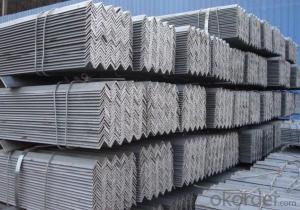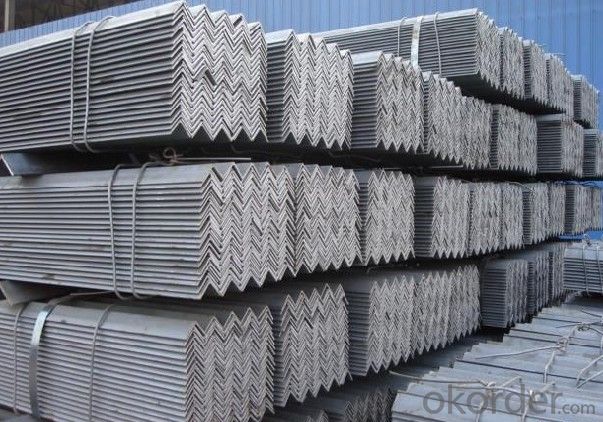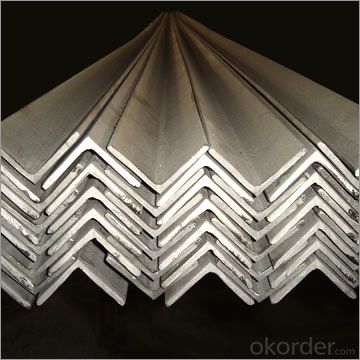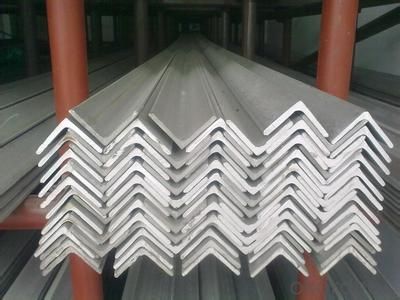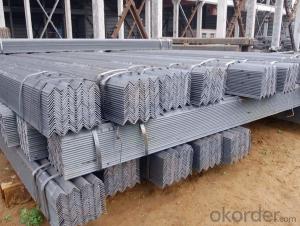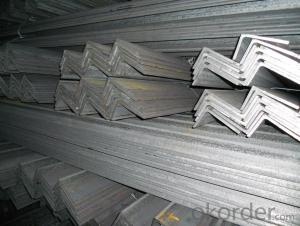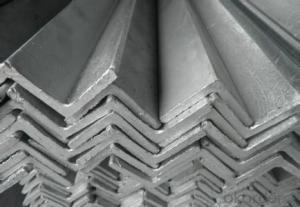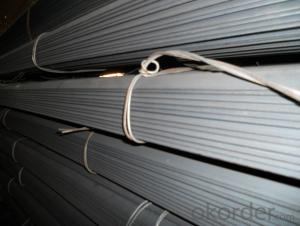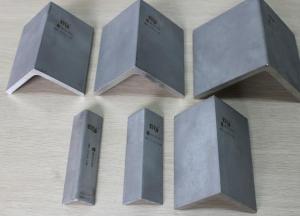high quality unequal angle
- Loading Port:
- China Main Port
- Payment Terms:
- TT OR LC
- Min Order Qty:
- -
- Supply Capability:
- -
OKorder Service Pledge
OKorder Financial Service
You Might Also Like
Product Description:
Stainless Steel Angles
1.Grade: SS200,300,400 series
2.Size: 25×25×3 mm-100×100×10mm
3.Process: HRAP
4. Length: 2-6m
5. Shape: Equal
6. Delivery: within 20 days
7. MOQ: 1 ton
8. Certificate: ISO 9001:2008, SGS
9. Package:Standard Export Packing, or put into wooden boxes according to your
requirement
10. Application: Construction, Marine, Industry and so on
Name | Stainless Steel Angles | ||||||
Standard | ASTM A554, A312, A249, A269 and A270 | ||||||
Material Grade | 304,316,201,202, 316L,430 | ||||||
Length | 6m or as customers' request | ||||||
Tolerance | a) thickness: +/-0. 15mm | ||||||
| |||||||
b) Length:+/-4. 5mm - 0mm | |||||||
Surface | 180G, 320G, 400G Satin / Hairline(Matt Finish, Brush, Dull Finish) 400G, 500G, 600G or 800G Mirror finish | ||||||
Application | Decoration construction, upholstery, industry instruments | ||||||
Test | Squash test, Extended test, Water pressure test, Crystal rot test, Heat treatment, NDT | ||||||
Chemical Composition of Material |
Composition
Material | 201 | 202 | 304 | 316L | 430 | |
C | ≤0.15 | ≤0.15 | ≤0.08 | ≤0.08 | ≤0.12 | ||
Si | ≤1.00 | ≤1.00 | ≤1.00 | ≤1.00 | ≤1.00 | ||
Mn | 5.5-7.5 | 7.5-10 | ≤2.00 | ≤2.00 | ≤1.00 | ||
P | ≤0.06 | ≤0.06 | ≤0.045 | ≤0.045 | ≤0.040 | ||
S | ≤0.03 | ≤0.03 | ≤0.030 | ≤0.030 | ≤0.030 | ||
Cr | 16-18 | 17-19 | 18-20 | 16-18 | 16-18 | ||
Ni | 3.5-5.5 | 4-6 | 8-10.5 | 10-14 |
| ||
Mo |
|
|
| 2.0-3.0 |
| ||
Mechanical Property | Material Item | 201 | 202 | 304 | 316L | ||
Tensile Strength | ≥535 | ≥520 | ≥520 | ≥520 | |||
Yield Strength | ≥245 | ≥205 | ≥205 | ≥205 | |||
Extension | ≥30% | ≥30% | ≥35% | ≥35% | |||
Hardness (HV) | <253 | <253 | <200 | <200 | |||
- Q: How are steel angles used in structural framing?
- Steel angles are commonly used in structural framing to provide support and stability to various building components. These angles, which are L-shaped, are used to connect and reinforce different elements of a structure, such as beams, columns, and trusses. One of the main uses of steel angles in structural framing is to provide additional strength and rigidity to beams and columns. By attaching steel angles to the sides of these components, the angles act as braces, preventing the beams or columns from buckling or bending under heavy loads. This is particularly important in large-scale construction projects, where the structural integrity of the building is crucial. Steel angles are also used to create connections between different structural members. For example, they can be used to connect beams to columns, providing a secure and stable joint. The angles are typically bolted or welded to both members, creating a strong and durable connection. Additionally, steel angles can be used to create framing for walls, roofs, and floors. By attaching angles to the top and bottom of these components, a rigid framework is formed, which can support the weight of the structure above and provide stability during construction. In summary, steel angles play a vital role in structural framing by providing support, reinforcing connections, and creating stable frameworks. Their versatility and strength make them an essential component in the construction industry.
- Q: What is the standard tolerance for steel angles?
- Depending on the specific requirements and industry standards, the standard tolerance for steel angles can vary. Typically, the permissible variation in dimensions such as length, width, and thickness is used to specify the standard tolerance for steel angles. These tolerances guarantee that the angles meet the necessary specifications and are suitable for different applications. To determine the specific tolerance requirements for steel angles in a particular context, it is important to refer to relevant industry standards or specifications provided by organizations like ASTM or AISC.
- Q: Are steel angles suitable for constructing bridges?
- Indeed, bridges can be constructed using steel angles. Due to their strength and versatility, steel angles are frequently employed in bridge construction. They can easily be fashioned into different forms and dimensions, making them well-suited for crafting structural elements like beams, columns, and trusses. Moreover, steel angles possess exceptional tensile strength, enabling them to endure the weighty loads and forces endured by bridges. Furthermore, steel angles boast excellent resistance to corrosion, guaranteeing the endurance and resilience of bridge structures. In summary, steel angles represent a dependable and economical option for bridge construction.
- Q: Can steel angles be used for stairs or handrails?
- Yes, steel angles can be used for stairs or handrails. Steel angles are commonly used in construction as they provide structural support and stability. When used for stairs, steel angles can be incorporated as stringers or supports, ensuring the stability and strength of the staircase. Similarly, for handrails, steel angles can be used as the main frame or support structure, providing a sturdy and safe handrail for users. The use of steel angles in stairs and handrails offers durability, resistance to wear and tear, and the ability to withstand heavy loads, making them a popular choice in construction projects.
- Q: Are steel angles suitable for earthquake-resistant structures?
- Steel angles are commonly used in earthquake-resistant structures due to their high strength and ductility properties. The angular shape of these structural members allows them to effectively resist lateral forces caused by seismic events. The ability of steel angles to absorb and dissipate energy during an earthquake makes them suitable for withstanding the dynamic loads generated by ground motions. Additionally, steel angles can be easily connected and joined together, providing a high level of structural integrity and ensuring the overall stability of the building. These factors make steel angles a favorable choice for earthquake-resistant structures, as they offer a reliable and durable solution for mitigating the impact of seismic events.
- Q: Are steel angles suitable for mezzanine floor construction?
- Yes, steel angles are suitable for mezzanine floor construction. Steel angles are commonly used in mezzanine floor construction due to their structural strength and durability. They provide excellent support and stability, making them an ideal choice for supporting the weight of the mezzanine floor and any loads placed on it. Steel angles can be easily bolted or welded together to create a strong framework for the mezzanine floor. Additionally, steel angles can be customized to fit specific design requirements, allowing for flexibility in mezzanine floor construction. Overall, steel angles are a reliable and cost-effective solution for mezzanine floor construction.
- Q: How do you calculate the bending capacity of a steel angle?
- In order to determine the bending capacity of a steel angle, several factors must be considered. The initial step involves calculating the moment of inertia (I) of the angle section, which measures its resistance to bending. The moment of inertia relies on the angle's shape and dimensions, and can be found in the manufacturer's specifications or through calculations. Once the moment of inertia has been obtained, the section modulus (Z) can be calculated as another indicator of the section's ability to resist bending. The section modulus is found by dividing the moment of inertia by the distance from the centroid of the section to the extreme fiber. Subsequently, it is necessary to establish the maximum allowable bending stress (σ) for the steel angle. This value is typically provided by the manufacturer or can be determined based on the desired safety factor and the type of steel being used. Lastly, the bending capacity (M) of the steel angle can be calculated by utilizing the formula M = σ * Z. This calculation provides the maximum moment that the angle can endure without experiencing excessive bending stress. It is important to note that these calculations assume the angle's behavior is elastic and do not account for additional factors such as local buckling, residual stresses, or combined loading. Therefore, it is advisable to consult relevant design codes or guidelines for a more comprehensive analysis to ensure the safety and reliability of the steel angle in a specific application.
- Q: Are there any environmental benefits of using steel angles?
- Using steel angles has numerous environmental advantages. To begin with, steel is one of the most recycled materials globally. When steel angles are no longer needed, they can be easily recycled into new steel products, thereby decreasing the demand for new steel production. This recycling process consumes less energy and resources compared to manufacturing steel from raw materials, resulting in significant energy savings and reduced carbon emissions. Furthermore, steel is a durable material with a long lifespan. This means that steel angles require less frequent replacement than other materials, leading to a reduction in waste generation. Steel's durability also means that it requires less maintenance and repairs over time, further minimizing its environmental impact. Moreover, steel is resistant to fire, pests, and rot, which reduces the necessity for chemical treatments and preservatives that can harm the environment. Additionally, steel angles have a high strength-to-weight ratio, meaning that less material is needed to achieve the same structural integrity compared to other materials. This not only reduces the amount of raw materials needed but also decreases transportation costs and fuel consumption during construction. Lastly, steel is highly versatile and can be used in various applications, such as construction and manufacturing. This versatility enables the creation of innovative and sustainable designs that optimize energy efficiency and decrease environmental impact. For instance, steel angles can be utilized in the construction of energy-efficient buildings that incorporate renewable energy systems, ultimately reducing overall energy consumption and greenhouse gas emissions. In conclusion, utilizing steel angles provides numerous environmental benefits, including decreased energy consumption, lower carbon emissions, reduced waste generation, and increased durability. These factors make steel angles a sustainable and environmentally-friendly choice for a range of applications.
- Q: Are steel angles available in different colors?
- Steel angles typically come in a standard metallic gray color, but it's possible to alter their color or appearance by applying different finishes or coatings. Options like powder coating, paint, or galvanization can offer a variety of colors to choose from. However, it's worth mentioning that the range of available colors may vary depending on the manufacturer or supplier.
- Q: What is the process of cold bending steel angles?
- The process of cold bending steel angles involves manipulating the angles into a desired shape without the use of heat. This is done by applying force or pressure to the angles in a controlled manner. First, the steel angle is secured in a bending machine or fixture that can hold it securely in place during the bending process. The operator then determines the desired angle and bend radius, which determines the amount of force that needs to be applied. Next, the bending machine or fixture applies pressure to the steel angle, gradually bending it to the desired shape. The force is typically applied slowly and evenly to prevent any deformation or damage to the steel. During the bending process, it is important to monitor the angle and ensure that it is bending evenly and smoothly. The operator may need to make adjustments to the pressure or angle of the bending machine to achieve the desired shape. Once the steel angle has been bent to the desired angle, it is carefully removed from the bending machine or fixture. It is important to handle the bent angle with care to prevent any distortion or damage. Cold bending steel angles offers several advantages over hot bending, such as reduced risk of material distortion or weakening due to heat. It also allows for more precise and controlled bending, making it suitable for a wide range of applications where accuracy is crucial. Overall, the process of cold bending steel angles involves securely positioning the angle in a bending machine or fixture, applying gradual and controlled pressure to bend it to the desired shape, and carefully removing the bent angle for further use.
Send your message to us
high quality unequal angle
- Loading Port:
- China Main Port
- Payment Terms:
- TT OR LC
- Min Order Qty:
- -
- Supply Capability:
- -
OKorder Service Pledge
OKorder Financial Service
Similar products
Hot products
Hot Searches
Related keywords
